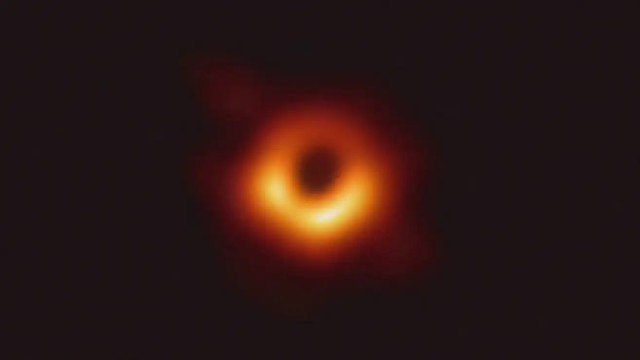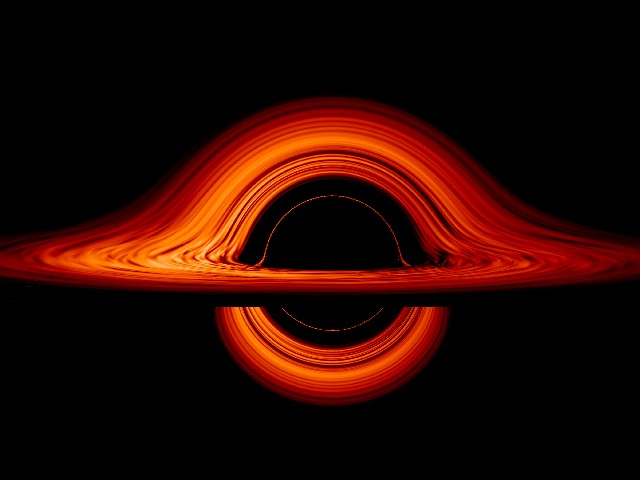
-
NASA Releases New Visualisation Of What It Would Be Like To Be Swallowed By A Black Hole [Video]
09 May 2024 by Tayla in Lifestyle, Science, Space, Tech/Sci, Video
[imagesource:wikimediacommons]
If you’re the kind of person who walks around life with a near-constant and quiet call of the void ringing out in the background, then this new NASA visualisation will be right up your alley.
You can also be a science and space nerd, more simply.
The space agency’s newest animation simulates the view of someone falling into a black hole, demonstrating how the bizarre objects warp light and space as you approach them.
Light can’t get out of a black hole’s event horizon – because its gravitational pull is far too powerful – which leaves astrophysicists speculating and theorising about what’s going on beyond what we can see. That’s why NASA scientists have dived deeper into that mystery with a cool animation that gives you a glimpse inside the black hole.
Black holes are some of the densest objects in the universe, notes Quartz. At the limit of the black hole is its accretion disk – that bright orange-yellow swirl of superheated material that the black hole has pulled to its vicinity. Occasionally, bits of the accretion disk fall into the black hole, causing visible flare-ups that astronomers can observe and document.
“I simulated two different scenarios, one where a camera—a stand-in for a daring astronaut—just misses the event horizon and slingshots back out, and one where it crosses the boundary, sealing its fate,” said Jeremy Schnittman, an astrophysicist at NASA’s Goddard Space Flight Center, in an agency release.
Matt McConaughey’s Interstellar character plunging into the inky black yonder has nothing on this supermassive black hole, 4.3 million times the mass of the Sun.
Even though we’ve managed to snap pics of black holes—remember that groundbreaking shadow captured by the Event Horizon Telescope in 2019?—they’re still super tough to photograph. That’s why astrophysicists rely on computer simulations to get a clearer picture of the mind-boggling physics happening as you get closer to these massive gravitational monsters.
The first image of a black hole was published in 2019, of a supermassive black hole 6.5 billion times the Sun’s mass.

Image: Event Horizon Telescope Collaboration
According to the release, an ordinary laptop would’ve taken over a decade to render the animation, but NASA Goddard’s Discover supercomputer completed the task in five days, using just 0.3% of its processing power.
The visualisation kicks off with the camera hanging out around 400 million miles away from the black hole, as mentioned in the press release. As you zoom in closer, things start getting seriously trippy as spacetime gets all wonky thanks to the black hole’s gravitational pull. And once you cross that event horizon, it’s a quick trip to oblivion, which Schnittman explains as being “spaghettified” in less than 13 seconds.
The music of the video meets the momentous mood of being sucked in by the big black abyss, set to Thomas Daniel Bellingham’s ‘Tidal Force’, Digital Juice’s ‘Memories’, and Eric Jacobson and Lorenzo Castellarin’s ‘Path Finder’.
The tunes sound like if Daft Punk, Hans Zimmer, and the composers of Runescape’s soundtrack got together for a last dance.
The release added that from the point of spaghettification, the viewer only has to travel 79,500 miles (128,000 kilometres) to reach the singularity at the centre of the black hole, a voyage through the black hole that occurs almost instantaneously.
Hello darkness, our old friend.
[source:quartz]
Latest News
-
Powerful South African Short Film ‘The Last Ranger’ Scoops Up Awards And International Praise
[imagesource: Cindy Lee Director/Facebook] A compelling South African short film, The L...
-
Caprice Summer Has Started With Brunch (But Better) This Saturday + Other Lush Camps Bay Parties
[imagesource: Instagram/cafecaprice] Is it just me or has Summer been taking its sweet ...
-
Notre-Dame Cathedral In Paris Restored And Ready For Grand Reopening After Devastating Fire
[imagesource:wikimedia] After five years of work and millions in donations, The Notre-D...
-
Self-Destructing Number Plates: The Future Of Gauteng’s Roads Or Spy-Tech Fantasy?
[imagesource:worldlicenseplates.com] What sounds like a James Bond movie is becoming a ...
-
I Changed My Relationship With Food And You Won’t Believe What Happened Next
[imagesource:supplied] As the festive season approaches, it's time to deck the halls, g...
-






























